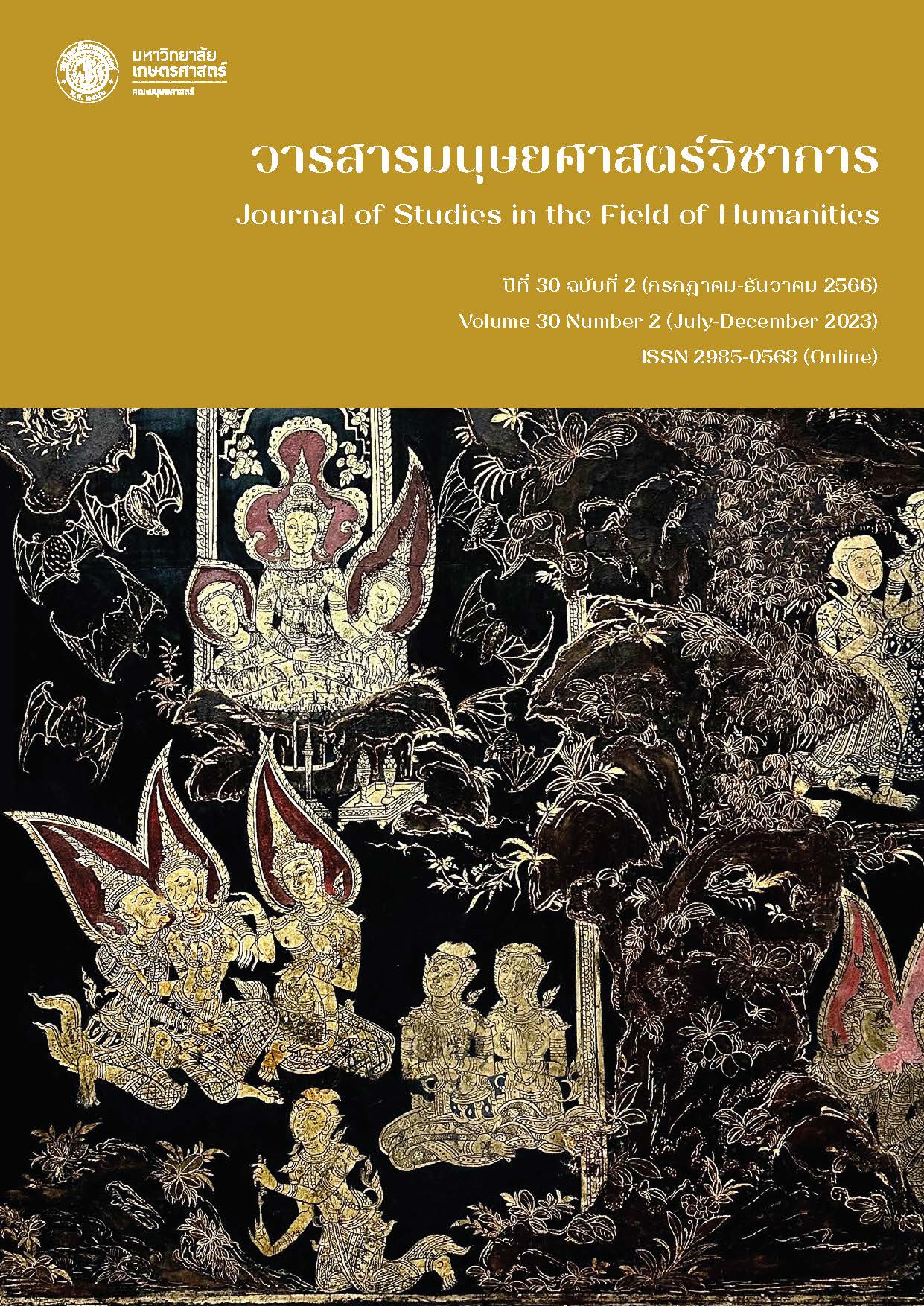The Important Skills and Online Risk Prevention in Fake News Evaluation for Adolescents
Main Article Content
Abstract
The advancement of information technology in the twenty-first century, along with changes in communication such as social media, has led to rapid information dissemination. Unfortunately, a significant portion of the presented information may be incorrect or false. This type of information is known as fake news, and it is intended to deceive many people. The impact of fake news is widespread, affecting people, society, and nations, including adolescents who are particularly vulnerable. To address this issue, the author proposes "The Model of Key Skills and Online Risk Prevention in Fake News Assessment for Adolescents," which consists of three parts: 1) a synthesis of key skill components, specifically media literacy skills, information literacy skills, and digital literacy skills; 2) online risks for youth; 3) fake news assessment. This model aims to equip adolescents with the necessary skills to identify and prevent online risks associated with fake news.
Article Details

This work is licensed under a Creative Commons Attribution-NonCommercial-NoDerivatives 4.0 International License.
References
นันทิกา หนูสม และวิโรจน์ สุทธิสีมา. (2560). ลักษณะของข่าวปลอมในประเทศไทยและระดับความรู้เท่าทันข่าวปลอมบนเฟซบุ๊กของผู้รับสารในเขตกรุงเทพมหานคร. Journal of Communication Arts, 37(1), 37-48.
พิชิต วิจิตรบุญยรักษ์. (2554). สื่อสังคมออนไลน์: สื่อแห่งอนาคต. วารสารนักบริหาร, 31(4), 99-103.
ราชบัณฑิตยสถาน. (2554). พจนานุกรมฉบับราชบัณฑิตยสถาน พ.ศ. 2554. กรุงเทพฯ: ราชบัณฑิตยสถาน.
วิศิษฎ์ เกตุรัตนกุล และคณะ. (2561). บอกต่อสุขภาพดีในสังคมไทยยุคปลอมปลอม. ใน Fake News วิกฤตสื่อในยุคดิจิทัล. (น. 23-27). กรุงเทพฯ: มหาวิทยาลัยสุโขทัยธรรมาธิราช.
ศูนย์ประสานการรักษาความมั่นคงปลอดภัยระบบคอมพิวเตอร์ประเทศไทย. (2563). ข่าวปลอมออนไลน์สังเกตอย่างไร ก่อนเชื่อและแชร์. สืบค้นเมื่อ 22 พฤศจิกายน 2565 จาก www.antifakenewscenter.com.
สำนักงานคณะกรรมการข้าราชการพลเรือน. (2565). Digital Literacy คืออะไร. สืบค้นเมื่อ 22 พฤศจิกายน 2565 จาก https://www.ocsc.go.th/DLProject/mean-dlp.
สำนักงานพัฒนาธุรกรรมทางอิเล็กทรอนิกส์. (2563). Fake News ลวงให้เชื่อหลากให้แชร์. สืบค้นเมื่อ 22 พฤศจิกายน 2565 จาก https://www.etda.or.th/content/living-in-the-fake-news-era.html.
Allcott, H., & Gentzkow, M. (2017). Social media and fake news in the 2016 election. Journal of Economic Perspectives, 31(2), 211-236.
Alvarez, J. S. (2021). Are 15-year-olds prepared to deal with fake news and misinformation? Retrieved December 1, 2022, from https://www.oecd-ilibrary.org/docserver/6ad5395e-en.pdf?expires= 1671161553&id=id&accname=guest&checksum=5054C16EE02719F6293E43BB2D9364B9.
American Association of School Libraries. (1998). Information power: Building partnerships for learning. Chicago: American Library Association.
American Library Association. (2000). Information Literacy Competency Standards for Higher Education. Retrieved December 1, 2022, from https://alair.ala.org/bitstream/ handle/11213/7668/ACRL%20Information%20Literacy%20Competency%20Standards%20for%20Higher%20Education.pdf?sequence=1.
American Library Association. (2013). Digital literacy, libraries, and public policy: Report of the Office for Information Technology Policy’s Digital Literacy Task Force. American Library Association (ALA). Retrieved December 1, 2022, from http://www.districtdispatch.org/wp-content/uploards/2013/01/2012_OITP_digitalreport_1_22_13.pdf.
Aspen Media Literacy Leadership Institute. (1992). Media Literacy: A Definition and More. Retrieved December 1, 2022, from http://www.medialit.org/media-literacy-definition.
Bateman, C. (2021). Fake news: Half of UK kids saw more online misinformation in 2020, survey finds. Retrieved December 1, 2022, from https://news.sky.com/story/fake-news-half-of-uk-kids-saw-more-online-misinformation-in-2020-survey-finds-12213722.
Cordell, R. (2013). Information literacy and digital literacy: Competing or complementary?. Communication in Information Literacy, 7(2), 177-183.
Desai, S., Mooney, H., & Oehril, J. A. (2018). Fake News, Lies, and Propaganda: How to Sort Fact from Fiction. Retrieved December 1, 2022, from https://www.projectcora.org/ assignment/fake-news-lies-and-propaganda-how-sort-fact-fiction.
Dooley, J. J., Cross, D., Hearn, L. and Treyvaud, R. (2009). Review of existing Australian and international cyber-safety research". Child Health Promotion Research Centre, Edith Cowan University, Perth. Retrieved December 10, 2022, from www.dbcde.gov.au/__data/assets/pdf_file/0004/119416/ECU_Review_of_existing_Australian_and_i nternational_cyber-safety_research.pdf.
Dumitru, E. A. (2020). Testing children and adolescents’ ability to identify fake news: A combined design of quasiexperiment and group discussions. Societies, 10, 71.
Fernandez, M., & Alani, H. (2018). Online Misinformation: Challenges and future directions. In Companion of the The Web Conference 2018. In International World Wide Web Conferences Steering Committee, 595–602.
Fielder, A., Gardner, W., Nairn, A., & Pitt, J. (2007). Fair game? Assessing commercial activity on children’s favourite Web sites and online environments. Retrieved December 10, 2022, from www.agnesnairn.co.uk/policy_reports/fair_game_final.pdf.
Jaster, R. & Lanius, D. (2018). What is Fake News?. Versus 2(127), 207-227.
Lazer, D. M. et al. (2018). The science of fake news. Science, 359(6380), 1094-1096.
Livingstone, S. (2004). What is Media Liberacy?. Retrieved December 10, 2022, form https://www.researchgate.net/publication/30521219_What_is_media_literacy.
Loos, E., Ivan, L., & Leu, D. (2018). Save the Pacific Northwest Tree Octopus: A hoax revisited. Information and Learning Science, 119, 514-528.
Nelson, C. (2022). What is Digital Literacy?. Retrieved December 10, 2022, form https://decodingdigitalliteracy.org/.
Organization for Economic Co-operation and Develop. (2011). The Protection of Children Online. Retrieved December 10, 2022, from https://www.oecd-ilibrary.org/docserver/5kgcjf71pl28en.pdf?expires= 1673146859&id=id&accname=guest&checksum=77916026204C8E551484F0C416E96416.
Positioning, (2014, August 13). User-generated content. Retrieved November 15, 2022, from https://positioningmag.com/58244.
Rubin, V., Chen, Y., & Conroy, N. J. (2015). Deception detection for news: three types of fakes. In Proceedings of the 78th ASIS&T Annual Meeting: Information Science with Impact: Research in and for the Community, 83.
Rubin, V., Conroy, N., Chen, Y., & Cornwell, S. (2016). Fake news or truth? using satirical cues to detect potentially misleading news. In Proceedings of the Second Workshop on Computational Approaches to Deception Detection, 7-17.
Sunstein, C. (2007). On Rumors: How Falsehoods Spread, Why We Believe Them, What Can Be Done. New Haven: Yale University Press.
The Royal Society. (2012). Forward for Computing in UK Schools. Retrieved December 10, 2022, from https://royalsociety.org/topics-policy/projects/computing-in-schools/report/.
Tornero, J. (2004). Promoting Digital Literacy. Retrieved December 10, 2022, from https://www.researchgate.net/publication/271505720_Jose_Manuel_Perez_Tornero_Promoting_Digital_Literacy.
Tornero, J. (2008). Media Literacy: New conceptualization, New Approach. Retrieved December 10, 2022, from https://core.ac.uk/download/pdf/288483471.pdf.
Volkova, S, & Jang, J. Y. (2018). Misleading or falsification: Inferring deceptive strategies and types in online news and social media. In Companion Proceedings of the The Web Conference, 575-583.
Volkova, S., Shaffer, K. Jang, J. Y., & Hodas, N. (2017). Separating facts from fiction: Linguistic models to classify suspicious and trusted news posts on twitter. In Proceedings of the 55th Annual Meeting of the Association for Computational Linguistics, 647-653.
Wooley, S. C., & Howard, P. N. (2018). Computational Propaganda: Political Parties, Politicians, and Political Manipulation on Social Media. Oxford: Oxford University Press.
Xu, S., Shtulman, A., & Young, A. G. (2022). Can Children Detect Fake News?. In Proceedings of the Annual Meeting of Cognitive Science Society, 2988-2993.


